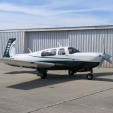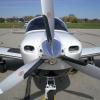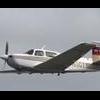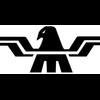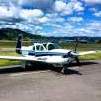Search the Community
Showing results for tags 'Engine'.
-
Dear mooney colleagues, I have a problem with an ordered new Continental engine and it would be great if you could help my in this case. I had an engine failure with my mooney in February 2024 and luckily, I could land safely on a field without any damage. The engine has major defects and already more the 2000 hours, which made it not viable to get repaired. Therefore I ordered a factory new engine TSIO360SB2B at Continental via the dealer Air Power. The delivery time should have been mid of November 2024. Short before delivery, Air Power informed me that Continental has one component missing, so they cannot complete the engine and they want to cancel the order. I did not agree, because I need a new engine. Since then, we have a long discussion with long waiting time for answers. Basically, the missing part is the throttle body, Continental p/n 646999-3 We still have this throttle body from our old engine, and according to my maintenance company in Germany, the part is in good condition. Therefore I suggested to Continental to use this part and change the order to a factory-rebuild engine instead of a new engine. After more the 2 months, I still do not have an answer whether we can do like proposed. I am grounded since almost 1 year now and I need a solution. Do you think, using the existing part from the old engine and build it into a factory-rebuild engine is possble? Do you have any idea how to get this throttle body on the market as a new part? Do you have any other suggestion for me, how I can get either a new or and overhauled engine TSIO360SB2B. Thank you for your help and comments, best regards, Stefan
- 14 replies
-
- 1
-

-
- tsio360sb2b
- throttle body
-
(and 2 more)
Tagged with:
-
Alright Mooney group bear with me, this may get a little long winded. New Pilot and even Newer Mooney pilot. So, i just finished my 15 hours to be checked off by insurance. I now have about 20 hours in my new (to us) 1967 F model. We bought it with about 25 hours on a new engine, and just completed our first oil change as well. Lots of firsts going on here. So, I am new to complex aircraft as well. When performing our run up we normally lean the mixture to best power similar to what we did in the 172. Run up to 1800 rpm, full forward on the prop, and slowly lean until power loss catch it and give a few extra turns once the power is back. Then we pretty much haven't touched the mixture on any flight. I played with it a little the other day in cruise, lowering it until it got rough and then adding it back in until it was smooth. Our checkmate checklist says cruise around 2600 rpm on the prop, but once setting the prop you cannot use RPM as a good lean indicator correct? Plus to add to complication our fuel pressure gauge is out (so I cant just put it at the bottom of the green) which would be running it efficiently correct? (Also new avionics coming in a couple months) So the only time I have tried to lean it in flight was in a cruise the other day I leaned it until it ran rough, then twisted it back in to run smoothly. Which the POH says don't lean the power above 75% power... but at full throttle I am sure I am above that. Did I hurt the motor? How on earth do you calculate percentage of power? Then there is the throttle. I figured on a brand new engine you wouldn't want to run it at WOT all the time due to wear on a new engine. But my CFI said run it full and manage RPM and Fuel flow with the mixture and prop, but my Dad (Airforce Pilot/commercial pilot of 30 years) said he would also be worried about wear on the engine, but thoroughly admitted I probably have more experience in a civilian airplane than him at this point. Ours is also turbo normalized as well, and all I have been told about it is to keep it below 28 MP. All of this has added a ton of confusion in my mind, so I went to the internet. Specifically another post on here: Which added even more confusion. I also realize I probably sound like an idiot, but I am okay with that if it helps me figure all this out by asking the experts. So to summarize my questions: 1) Is our best mixture practice during run up correct? 2) When leaning for efficiency, can you use RPM drop with a constant speed prop, fuel pressure indication, or leaning it until its rough then adding it back in? Which is correct or are all correct and some are just better than the other. 3) Is WOT the correct way to fly? Is the POH out of date as stated in the message board above. 4) Is 2600 RPM that the checkmate suggests the best cruise setting on prop? 5) Have I hurt the engine buy leaning with full throttle in and potentially getting over 75% power setting? 6) How on earth do you correctly measure % of power? (This one is probably easy but I am missing it) 7) Does any of this change when adding in the turbo? Thanks everyone!!! I know that is a lot to follow but any response, guidance, or videos would be much appreciated. Fly safe, The FNG
-
High-definition inspection cameras are becoming an essential tool in the industrial inspection world. Combining the capabilities of video inspection endoscope cameras, industrial inspection tools, and pipeline inspection equipment, these high-resolution devices provide exceptional clarity through wireless imaging and powerful LED lighting. This article explores the benefits of high-definition inspection cameras and their importance in a variety of industrial applications. Table of contents Main features of HD inspection cameras Applications: From industrial equipment to pipeline inspection Core advantages of high-definition inspection cameras How to choose the right HD inspection camera Conclusion: The Future of Nondestructive Testing The main features of HD inspection cameras High Definition Inspection Cameras offer a wide range of powerful features tailored for industrial use. These cameras combine the functionality of a video inspection endoscope and provide the following key features: High-resolution video: Capture detailed HD footage that clearly shows the tiniest defects. LED Lighting: Adjustable LED lights provide clear visibility even in low-light environments. Wireless imaging: Allows users to view inspection results in real-time on mobile devices, improving operational efficiency. Remote Viewing: The long, flexible probe allows users to easily inspect hard-to-reach areas without disassembling the device. Applications: From industrial equipment to pipeline inspection High-definition inspection cameras have a wide range of applications in various fields, including but not limited to: 1. Industrial testing Regular inspections of industrial machinery are essential. High-definition inspection cameras allow users to identify wear, corrosion or cracks within equipment, enabling preventative maintenance and reducing downtime. 2. Pipeline inspection Video inspection borescope cameras are indispensable tools in pipeline inspections . Their flexible probes and high-resolution imaging capabilities allow for a thorough inspection of the inside of the pipeline to reveal blockages, cracks, and other potential problems. 3. Aviation and automotive industries In the aviation and automotive sectors, endoscopes and high-definition inspection cameras ( borescopes ) are used to inspect the internal structure of engines and mechanical components to ensure the safety and proper operation of the equipment. 4. Nondestructive Testing (NDT) High-definition inspection cameras are ideal for non-destructive testing, allowing detailed internal inspections without disassembling equipment. This method saves time and costs, so it is widely used in the construction, manufacturing and maintenance fields. Core advantages of high-definition inspection cameras There are several key advantages to using a high-definition inspection camera: benefit describe High-resolution imaging Detects tiny defects and helps users identify potential problems. Flexible probe design Supports probes of various lengths and diameters, suitable for complex environments. Wireless connectivity Real-time viewing on mobile devices enhances ease of use. Enhanced LED lighting Ensure clear images even in dark environments. Portable and efficient Small and portable, it is perfect for on-site inspections and quick assessments. How to choose the right HD inspection camera When choosing an HD inspection camera, consider these key factors: Resolution and image quality: Cameras with higher resolution can capture clearer images, which is critical for identifying tiny defects. Camera Diameter and Probe Length: Choose the appropriate probe length and diameter based on the application. For example, pipeline inspections typically require a longer probe, while engine inspections may require a thinner probe. Wireless connectivity: Make sure the device supports wireless imaging, allowing users to view and control the camera through a smart device. Adjustable LED Lighting: The camera with adjustable LED lights can adapt to various lighting conditions, ensuring clear visibility in any environment. Waterproof and heat-resistant: When using in humid or hot environments, choose a device with waterproof and heat-resistant features. Conclusion: The Future of Nondestructive Testing As technology continues to advance, high-definition inspection cameras will continue to play an important role in industrial and technical inspection. As artificial intelligence (AI) and augmented reality (AR) are incorporated into these devices, they will provide enhanced analytical capabilities and automated inspection functions, further improving inspection efficiency and accuracy. High-definition inspection cameras are the ideal tool for modern industrial inspection, providing precise, non-destructive assessments in a variety of applications. Whether it is video inspection endoscopes, pipeline inspections, or aircraft engine inspections, these cameras provide clear, reliable imaging, helping users "see the invisible" and enabling significant advances in industrial diagnostics.
-
- boresco
- borescope camera
-
(and 7 more)
Tagged with:
-
Hey. Recently a good friend purchased a gorgeous 1963 Mooney M20C. Brand new paint job, 500 hours left on the engine, brand new prop. After picking it up, after an exhausting flight across the country in turbulent weather he wrecked it in a gear-up landing. For a gear-up landing it's in relatively good shape but the mechanic he talked to thinks his insurance will probably just total it, and he is, understandably, very overwhelmed and distraught at the thought that the plane he's been pursuing for months and saving up for for years might be done after just getting it home. Does anyone have any insight as to how to help lower costs and save his plane? As far as we can tell, he needs the belly panels replaced, definitely needs a new prop (2 or 3 blade is fine), and potentially will need to overhaul the engine. Everything else seems to be okay, and neither wing was damaged.
- 66 replies
-
- 1
-

-
- prop strike
- landing gear
-
(and 12 more)
Tagged with:
-
I have owned N1084L, a 1997 J for 10+ years. TTAE 1806. Oil consumption has gradually increased from 9 hrs/qt to 4. Regular oil analysis has never shown high metal levels. I changed oil after returning from flying in Caravan to KOSH, and found small metal flakes in filter for first time. With 20 year Lycoming limit for Rebuilt for Overhaul Price Proram coming up (June 2016) looks like it's time to go ahead & order rebuilt IO360A3B6. I haven't received latest oil report yet. Alan Millet
-
Good evening all. I’m looking at planes and considering an upgrade. I looked at an Acclaim and the Hobbs on the rear bulkhead was at 1400ish while the tach was at 900 ish in the G1000. The spread seems very high. I would have guessed maybe 20%. Is this a normal spread? Thanks in advance.
-
I just got my plane back from Annual, It ran perfectly beforehand and no squawks going in. (A little history ... Converted the engine to Ovation 3 (310hp) at last annual – Only engine change required is increasing prop governor speed and increasing fuel flow. Anyway as I said it ran perfectly for a whole year.) Nothing was found to be an issue during annual except the Spark plugs were apparently out of tolerance and replaced. They ran engine afterwards and everything was OK. Went down today to fly it for the first time since signed off a couple days ago. Engine running rough. #1 cylinder not making power. They checked it out and thought fuel injector nozzle to cylinder #1 was getting plugged (as part of the annual they ultrasonically cleaned all injectors). Recleaned the injector put back together. The issue then changed to Cylinder #2, Repeated the process, Recleaned put back together. The issue change to Cylinder #3, Repeated the process, Recleaned put back together. The issue changed back to Cylinder #1, - They tried with the old plugs back in; They rechecked magneto timing - no change. (BTW The Magneto is hundreds of hours away from it’s 500hr overhaul) They disconnected and checked the fuel going to each cylinder using the fuel pump and reported has debris?? They think a gasket or something might be disintegrating in the Fuel manifold that sits atop the engine. That’s as far as they got today. (BTW The spark plugs were changed from Champion fine wire to Tempest, but they’re convinced it’s the fuel side of combustion that’s causing the problem.) Questions: 1) Is this just incredibly bad and coincidental timing – (first time check out after annual – running fine beforehand) or could it be related to annual. To my knowledge the only part of the annual that involves the fuel system is cleaning the fuel screens and Injectors. 2) Does it make sense to jump from Cylinder to cylinder? 3) Any other thoughts as to cause, or what’s gone on would be appreciated Thanks in advance Roger
-
So, a friend has gotten me interested in looking at certificating the Chevrolet LS3 engine for airplanes (or one of the 4th generation LT engines). Looking into it, there are a lot of advantages. I am not afraid of the certification process. Thoughts? PS. Yes, I know about the Porsche engine/airplane (M20L)
-
Ovation owners, how does the top of the cowl line up with the spinner on the 310 HP Harzell 3 blade prop combination ? Wondering about the engine mounts and how much difference between new and old support. Anyone have experience with this? Thanks
-
I recently flew with the manufacture to learn the procedures they recommend for proper engine break-in.
- 4 replies
-
- 2
-

-
- engine break-in
- engine
-
(and 1 more)
Tagged with:
-
Hello all, I'd like to pick your brains on a problem which has been driving me slightly miffed in recent weeks. I own my C model since 2009 and since then, usually start up was never a problem at all. Our procedure as set was always the same: - Electrical fuel pump on, till pressure shows, then off. - Priming 6-8 times with the throttle (cold engine) or 2-4 times (warm engine) - Engage starter and the engine would run. Since this year, start up has become a real pain. I've had to leave the airplane two times unable to start it, had to request mechanic assistance (ext power) twice more and I keep getting feedbacks from the other pilots. The engine turns, most of the time fires shortly but when you disengage the starter,it stops. In subsequent tries,it either never ever fires again or again just once or twice. What we found is that during the start up one has to pump vigorously with the throttle, which sometimes leads to a start. 2nd and 3rd start after the engine has run is unproblematic, even though even then pumping the throttle is required. In two unsucessfull attempts, the engine definitly was drowned, with fuel leaking on the front tyre. Two of the pilots report they have NO problems at all and think we are too stupid simply. Well, it's possible,but we follow the exactly same procedure (one of them filmed it) and have no success. As I said, the previous years we never had any problem whatsoever. Maintenance has looked at it and found nothing wrong, even though they also were unable to start the engine at least once. They report, plugs and magnetoes are fine, carburettor as well. My feel is the engine does not get enough fuel the first start, then finding a good mix for starting in following attempts is difficult. Any idea on where to start looking would be appreciated. We have a major problem with this, as our airport has departure slots and we can't afford dicking around with the engine for hours every time we want to go flying. I also feel this is not how a standard O360 A1D should behave. Thanks a lot.
- 71 replies
-
I am sure this subject has come up before, but I can't find the details needed. Many publications discuss the cost of an engine overhaul, different options, different suppliers, etc. Yet I would like to know how much more the aircraft owner has to put aside for the items typically not included. And numbers from within the last 5 or max 10 years are of course more interesting than older bills. Consider your IO-360 has lasted 30 years and never failed, and now it's time for major work. Engine accessories are almost always included or listed, but what about the following firewall forward items which aren't any younger : engine mount - inspection and repair, exhaust - new (if welding isn't economical), oil cooler, and the related cost of labor, shipping, taxes, etc. Anything one cannot simply postpone until it really requires replacement or overhaul because that would come even more expensive. Any real data / bills / experience on this very welcome. It is clear that the cost will vary a lot from case to case. Would could be a worst case ?
-
Hey there everyone! I’m having a weird issue with my bravo. I’m having EGT fluctuations that happen in all cylinders at the same time. They first cool down 20-50 degrees then back up 60-70 and back to where they were when I leaned the engine out. This is in level cruse flight without any adjustments to the prop, mixture or throttle. My suspicion is the engine driven fuel pump. The only other correlated indication I’ve noticed is the fuel PSI gauge which will flicker from it’s normal cruise level of 40psi to 36 or so for just a second. Shortly thereafter the EGTs start their rollercoaster. Common sense tells us the engine is getting less gas during the rise and falls because of the rise and falls of the EGT and the correlated fuel PSI indication makes me believe the engine driven fuel pump is on its way out. I’ve attached a video of one of the more tame fluctuations I’ve managed to catch on video. Side note: I’ve had a mechanic check this out and I was told “I’ve never heard of an engine driven pump going out before” they didn’t find anything else relevant. Any help at all 20906550-E036-4103-9F85-CC15F5E65322.MOV is greatly greatly appreciated! 20906550-E036-4103-9F85-CC15F5E65322.MOV
-
On the E the oil lines from the cowl mounted cooler both route under P/N 620014-3 "Oil Line Shield", which shield the lines as they pass under the exhaust headers above them. When I pulled the lower cowling, there were two rubber lined hose clamps up under the shield attaching the hoses to it. I cannot find any mention of those clamps in the manuals or in SBs. Any guidance on these. Abashedly, I also cannot remember how they were attached and don't want to bother reattaching them if they aren't required.
-
I suspect my engine is sagging and this causing the cooling issues I'm having. So, is it shims or is it mounts? How do you evaluate the state of the mounts? Since I just replaced the donuts (and my gawd how my landings/ground handling have improved), it may be 'time' for the mounts.
-
So, I am now understanding why I have had high cylinder temps with my engine. The baffle seal is completely shot and I am beginning to wonder if the lower portion has ever been changed (see photo). The top seal is a patchwork of various black and orange pieces so while we are working a cylinder issue I've decided to replace the seals. Does the front lower cowl need to come off completely to get at the row of rivets, or is there some trick (like a partial removal)? Thanks!
-
All American Aircraft recently sold a Mooney Rocket with an engine rebuilt by Dugosh. Dugosh replaced the Contnental cylinders with ECI cylinders. Are ECI cylinders better or more durable than the Continental cylinders?
-
I had a case of severe morning sickness a week ago, see attached JPI graph, the log was started about 30 seconds after start, it appear to only be running on 1 cylinder, which is rather impressive. I've had this before but it's always been on cold mornings After it recovered everything was normal, I flew it for another 20 hours and engine ran great, I put in some Marvel Mystery Oil and flew for an hour today, then changed oil, any other preventive measures I can do?
-
I just bought a used 1979 turbocharged 231 mooney. I need to replace the engine, however I do not want to put another turbo CHARGED engine in. Can I do this? Also i would prefer a Lycoming engine instead of a Continental.
-
I am upgrading my two year old JPI EDM 830 system to a EDM 900 Primary. (My Mooney 262 has the TSIO360MB4B engine). The system for sale includes everything available for monitoring a turbocharged engine - EGT 6 Probes, CHT 6 Probes, 1 TIT Probe, Volts, Shock Cooling, LOP/ROP JPI Exclusive Leaning Mode, Fuel Flow (USED, Remaining, GPH Endurance, GPS Destination), 201 fuel flow transducer - fuel pump type, RPM, MAP, Oil Temperature/Pressure, OAT probe,% HP, Power Connector, All required harnesses, EZTrendsData recording, 100 hrs Download USB 1 GB Memory Stick, Selectable Positions for Linear gauges, Manual and all other paperwork. The wiring harness will be new and untrimmed. A new unit with all these options is $2660 at Spruce plus tax/shipping. I would like to get $ 1800, shipping included. Check, cash, cc accepted. Thanks, Jeff 208-720-2506 flyingfalconpllc@gmail.com
-
3,500 hours of flying and it finally happened. First "real" engine issue in 25 years of flying. Happened over big mountains just outside McCall, Idaho with the whole family on board too. Worst part was, I didn't even realize it happened until the next day! We went to KMYL (McCall) for a $100 hamburger lunch on a beautiful winter day. 1968, M20F with IO-360A1A. 800 hours SMOH (1998), top overhaul with rebuilt cylinders after prop strike (prev owner) in 2004. Flight down there was normal. Departed about 2pm so the kids (1 year old twins) were right at nap time for the way home. Chosen route was up the Little Salmon river valley over highway 95. There are dirt strips about 40 miles apart in the canyon, but there's basically nowhere to land northwest of KMYL for the first ~30 minutes of flight. Leveled off at 8,500' below a scattered deck and leaned for 20 LOP. Maybe a minute or two later I noticed my speed decreasing and autopilot telling me to trim up. I had lost ~10 knots from normal cruise. First thought was that I set the mixture too lean and was at too low a power setting. Rich mixture, surge forward pretty good, reset to 20 LOP and everything seemed fine. Then I decided to climb above the clouds, adjusted mixture, climbed, reset mixture and it happened again. Huh, interesting. By now we were 30 minutes from home and I didn't really think anything was wrong. Flew along ROP for a while, checked TAS and it was normal, JPI 930 showed normal engine indications. Reset LOP and noticed a very slight vibration. Actually thought about looking into balancing my prop. Landed uneventfully. Thought about the flight and didn't feel right... took off the cowl the next day and checked for leaks around the injectors. Everything seemed normal. Downloaded from EDM 930... didn't like that at all. Pictures below. Watch #3 EGT after leaning. The last picture is right before the decent to landing. They are at a different time scale, so they look a little different, but clearly #3 EGT was not behaving. It was going above it's leaning "peak" and then by the end of the flight, it was pretty unsteady. It had only climbed about 100 degrees from peak and was not noticeable on the EDM unless I had written down the peak values which I don't think anyone does. The fluctuating EGT wasn't noticeable without staring at the EDM which I didn't do. Sent the data to my mechanic and put it in the shop the next day. #3 exhaust valve was shot. The valve guide is worn excessively and the valve and guide have deposits causing it to stick and wobble. While he had that side of the engine apart, looked at #1 and it was not as bad but going down that road. Pulling 2 cylinders to send to an engine shop for new valves and redo the guides, etc. $$ Ouch. Oil samples done at each change and all normal (last one in December). Thankfully caught early enough that it didn't stick and fail catastrophically over the mountains. Any idea what causes this? Am I doing something to the engine to cause it? I guess I'd just feel better if I could see this coming a little before it starts affecting power. Don't want to have any power loss in the mountains, on takeoff, high DA, or all three! Appreciate your thoughts...
-
I'm looking to buy a nice 231 that has a run out engine and factored this cost into the purchase. Besides a reman engine from Airpower or major overhaul, what would good long term viable new engine options for the TSIO-360-GB1 that the plane currently has in it. It's a nice Mooney with great updated avionics and flies smooth.
-
Lycoming IO 360 A1A 200HP Fuel Injected 1300 SMOH $13,000 Complete John 386-467-0095 or 815-210-2675
-
I'm looking at the log books for a lat(er) model J and something is amiss. In the engine logbook, there are consistent annual inspections with 200-300 hours put on the engine in each year. However, there are no other entries between the annuals...no oil changes, no "oh fixed a little item here", nothing... Either this is the best running IO360 that has never had a hiccup, or there are missing entries. If you were looking at the airplane for your own, would you a.) Run away!, b.) Pre-buy the snot out of it, perhaps including some engine dis-assembly?, c.) Other. I'm not emotionally invested into any of it...still looking to buy my 'first airplane last'.
- 14 replies
-
So since it appears that this is another one of those "All In" Annuals,We (Charlie, my local IA and I) decided to change the old engine mounts (With the approval of the banker - AKA wife) this year. "May as well", was my answer since we are topping the engine. The old and new mount from the lower right are side by side in the pics. Not only had it twisted because it wasn't installed aligned with the dial pin on the frame, but it was over-torqued and had completely collapsed. A picture is worth a thousand words, but all I could say after we removed these was "Wow".We also have engine angle pics before and after that I'll post when the new cylinders and baffling are installed.As an aside, anyone thinking about replacing or overhauling a Lycoming cylinder, give Airpower a call. Their prices are unbelievably good on factory new as well as Superior, and ECI kits. Considering that Factory new came with new piston pins and caps the price was minimal in terms of difference. Add in a 2yr warranty parts and labor on Lycoming cylinder kits with unlimited hours and it was a no-brainier. Having peace of mind that the Cam is in impeccable condition, I figured it to be worth a topping now to guarantee running to TBO and maybe a little extra if condition permits. I'll follow up throughout the break in process with how the MVP 50 reports and how all develops for anyone interested.I will say that this is the most extensive owner assist work that I have ever done, and I certainly have a renewed respect for A&Ps :-).





.thumb.jpg.d6587805f8b8e570abb5031d411c7e80.jpg)
